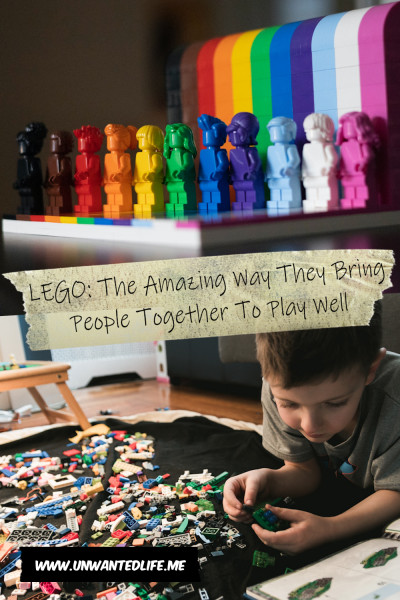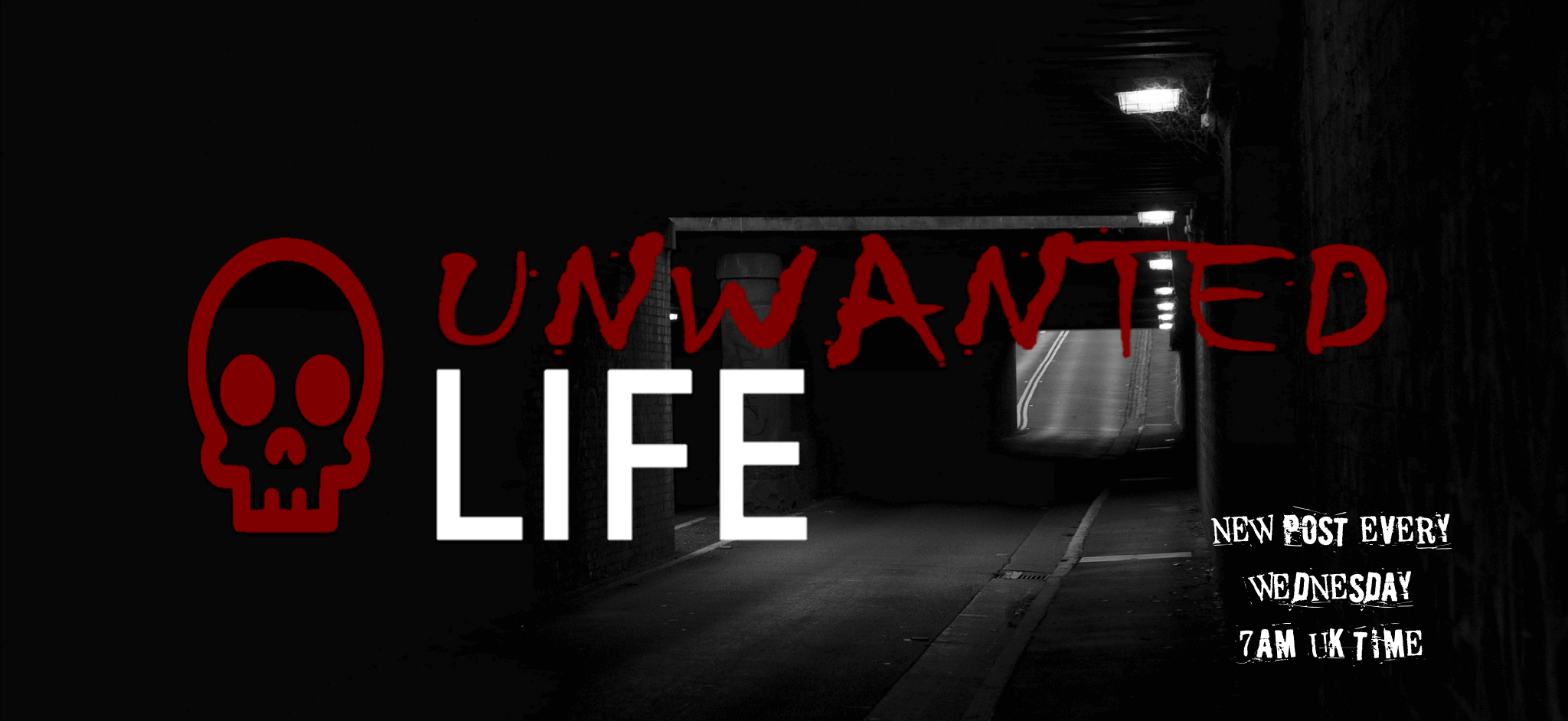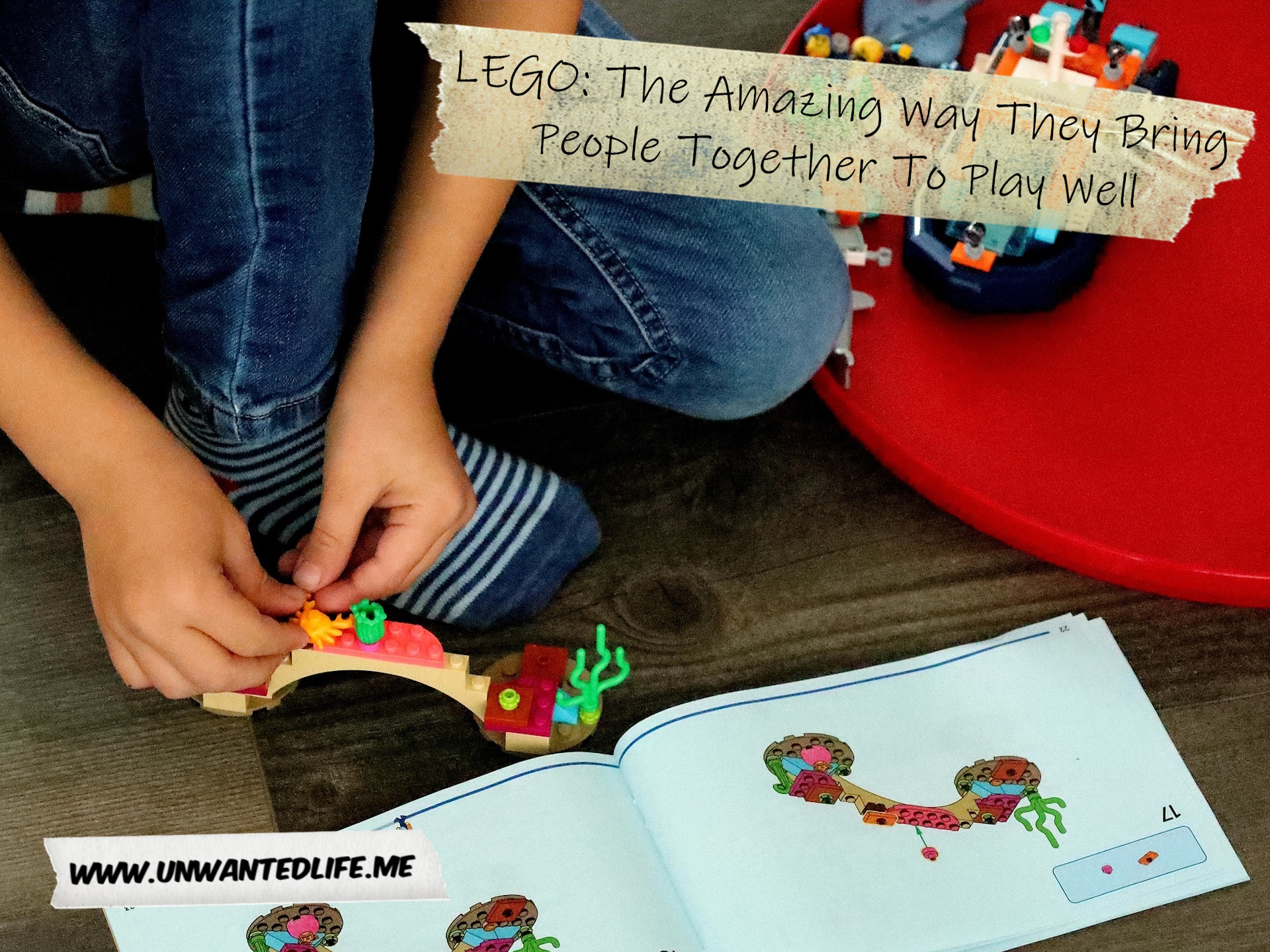So why am I talking about Lego today? First off, I’m doing it to celebrate International Lego Day, which is held on January 28th each year to mark the day when Godtfred Kirk Christiansen (Danish carpenter) submitted his first patent for the original Lego brick in 1958. The other reason is because Lego is very inclusive and good for our wellbeing.
What Is Lego?
In case you’ve never heard of Lego, they are a line of plastic construction toys or bricks in various shapes, sizes, and colours which allow you to build freely or follow an existing design by building one of their many sets. As for the name Lego, that comes from an abbreviation of two Danish words “leg godt”, meaning “play well”. Hence the title of the article.
Now that they’ve also changed their 4-99 age restriction, Lego is truly suitable for anyone over the age of four, meaning there’s something there for people of all ages. Obviously, the 4-99 thing was more of a light-hearted joke that anyone over four could build with Lego, but now many people live past the age of 99, thus the change.
How Lego Has Strived To Be Inclusive
The renowned toy company that is Lego has been making strides towards inclusivity for years, embracing diversity and representation in its products, marketing, and initiatives. These efforts have enhanced the brand’s image and positively impacted the wellbeing of individuals and communities worldwide.
Lego therapy
Lego-Based Therapy is a social development program that utilises Lego to support the development of a wide range of social skills within a group setting, originally designed to help those with autism (ASD; Therapy Focus). Some of the skills it’s meant to help develop are sharing, turn-taking, using the names of those in the group, following rules, and problem-solving (The National Autistic Society).
The claim that this can help develop social skills among those with ASD was found in a study by LeGoff (2004), who created Lego-Based Therapy. This study was based on 47 children, with five groups of seven and two groups of six children, all of whom were ASD. The findings found improvements across three measure areas: language impairment, social skills, and coping deficits.
According to raisingchildren.net.au, this form of therapy is run by trained facilitators running groups that are one to two hours long. In each session, a child is allocated a role, and over the course of the therapy sessions, they’ll rotate these roles as they build Lego sets. Roles such as an engineer (who has the instructions), a supplier (who has the bricks), and a builder (who builds the model). This setup is what fosters the development of social skills.
For more information on Lego-Based Therapy, check out this article on PositivePsychology.com by clicking here or the article by Therapy Focus by clicking here.
Representation
Lego has introduced a broader range of characters and sets that reflect the diversity of the world’s population. This includes characters of different genders, ethnicities, abilities, and backgrounds, allowing children to see themselves represented in the play world. Furthermore, these diverse sets encourage children to create stories and scenarios that reflect the world around them.
They have moved away from traditional gender-based marketing, encouraging children of all genders and ages to engage with their products. This promotes inclusivity and challenges gender stereotypes, allowing children to explore their interests without limitations.
Lego has also incorporated accessibility features into its products and playsets, making them more inclusive for children with disabilities. This includes braille signage, textured elements, and larger pieces for easier handling.
Lego brought out a set called the ‘Lego Ideas Research Institute’ in response to a call for toys that show girls and women in intellectual and positive roles (Museum of New Zealand – Te Papa Tongarewa). This set included all female figures in various science roles and was created by geoscientist Ellen Kooijman.
The set, ‘Everyone is Awesome’, created by Matthew Ashton, was created because they are part of the LGBTQIA+ community and thought more could be done to appreciate our differences. Representation is always important, and this set was designed to highlight that fact.
Lego braille
In 2023, Lego became available in braille in the English and French braille languages. In the same year, the BBC reported that such bricks help children who are blind or have sight issues learn braille while having fun. The BBC also reported how a grandmother, who was born blind and had been building Lego since they were a kid, can now do so with their grandchildren.
In 2024, it was announced on the Brick Fanatics site that the braille bricks will now include the German alphabet, Spanish alphabet, and Italian alphabet.
If you’re interested in purchasing a braille set or just checking out the product, then you can do so by clicking here (not an affiliate link).
Community engagement
The Lego company has partnered with organisations that promote diversity and inclusion, supporting initiatives that empower underrepresented communities and foster belonging. The exposure to diverse characters and perspectives that this company has strived for can foster empathy and understanding among children.
Lego’s inclusive toys also encourage children to appreciate different cultures, backgrounds, and abilities. Furthermore, inclusive play environments allow children to explore their creativity and imagination without limitations. By promoting inclusivity in its products and marketing, Lego contributes to a more inclusive and accepting society. This will hopefully lead to increased social cohesion and reduced prejudice.
The Wellbeing Benefits Of Lego
Playing with Lego can be a fun and engaging activity that has the potential to improve your overall wellbeing in several ways. Here are some ways that Lego can contribute to your wellbeing:
Relaxing
Lego, like many hobbies and interests, is good for helping us relax and unwind from life’s stresses (LEGO®). So if you’re looking for a new relaxing activity, why not try these wonderful plastic bricks? You could do this alone or with friends and family. I know my two closest friends build sets together (they’re dating), although I build mine alone, but I have plans to build the set my partner got me with them, at their request.
One of my other friends who recently had a child is waiting for the time they’ll be able to build Lego with their kid when they become old enough. But why wait? According to the Metro, adults have taken to building with Lego as a way to relax, but also as a way to help manage their mental health. Sharing interviews with people who’ve found this benefit. You don’t need to have kids of your own to enjoy Lego.
Social engagement
Building with Lego can also be a social activity, which can help improve social skills, reduce feelings of isolation and loneliness, and increase feelings of belonging and connection.
Hobby
One of the best bits of self-care advice is to find a hobby or interest that you can invest yourself in. When you do this, you can reach a state of flow (being in the zone). I’ve often found myself wanting to complete my Lego build, or the section I’m on, to the point I was experiencing a hypo and still trying to push through it. Lego is surprisingly enjoyable to play with, even as a 42-year-old Black man.
Mindfulness
According to LEGO®, more and more people have been using their product as a form of mindfulness. Because of this, Lego has released its first book aimed at adults, promoting mindfulness and wellbeing. The book is called: ‘Build Yourself Happy: The Joy of Lego Play’ (inews.co.uk). The reason for this is that it’s a relaxing activity that requires a level of mental engagement (LEGO®).
As the Metro put it:
The tactile joy of the little plastic pieces isn’t necessarily just a trivial time waster
Building with Lego can be a calming and meditative activity that promotes mindfulness and relaxation. It can help reduce stress and anxiety by focusing on the present moment and the tactile experience of building.
Inner child
It’s important to keep connected to our inner child because life can be quite dull without it. Our creativity often comes from that connection to our inner child as well. Remember, the stigma of an adult playing with Lego has gone, with shows (LEGO Masters) dedicated to adults building with these plastic bricks. People are even organising adult-only Lego building groups (The Washington Post). So why not connect with your inner child and flex that inner creativity all in one go by playing with Lego?
Self-esteem and belonging
Because of the efforts by Lego, seeing oneself represented in play and media can boost self-esteem and feelings of belonging, particularly for marginalised groups. This inclusive approach also helps children develop a positive sense of identity and belonging.
Stress management
Focusing on the building of your set or free build can help clear your mind and provide a sense of relaxation. According to comments made to The Washington Post, adults with high-pressured jobs are using Lego to help disconnect from their stressful days. The easy-to-follow instructions allow anyone to pick up a set and know if they follow the booklet, then they’ll achieve the design.
This clear path, while not too mentally taxing, makes playing with your favourite colourful Danish building blocks an alternative to meditation, allowing you to be present in the moment while reducing stress levels (Men’s Health). And once you’ve finished, you have evidence of your achievement.

Problem-solving
Building with Lego bricks can be a form of problem-solving, which can help improve cognitive functioning and reduce anxiety. The process of constructing something from scratch can help you tap into your inner creativity and come up with unique solutions to problems. As you build and create, you have to consider the functionality and stability of your creation. Thus, it can also provide a sense of accomplishment and satisfaction when completed.
Lego has also been used for educational purposes, such as in educational robotics, allowing people to learn problem-solving skills, among others (Souza, Andrade, Sampaio, and Araujo, 2018).
Creativity and imagination
Lego can stimulate creativity and imagination, which can help improve mood and reduce symptoms of depression. It can also provide a sense of playfulness and joy. Although I only got into Lego because I wanted to own all the Harley Quinn and Joker figures, it soon changed into wanting to create dioramas with these figures.
The process of constructing something from scratch can help you tap into your inner creativity and come up with unique solutions to problems. I may not be doing it entirely from scratch, but it is fun to think about how to combine sets and make them work for how I want to display my Harley Quinn and Joker figures.
Therapeutic tool
Lego can be used as a therapeutic tool for individuals with disabilities to work on specific goals, such as fine motor skills, spatial reasoning, and communication. According to Vintage is the New Old, older people can help retain their dexterity in their hands as well as improve mental agility by building Lego.
Boosts mood
Playing with Lego can be a fun and joyful experience that boosts your mood and makes you feel happy. The satisfaction of completing a build or creating something new can give you a sense of accomplishment and fulfilment.
Summary
Lego’s commitment to inclusivity not only enhances its brand image but also has a positive impact on the wellbeing of individuals and communities worldwide. By embracing diversity and representation, Lego has fostered self-esteem, empathy, creativity, and social cohesion, contributing to a more inclusive and welcoming society for all.
Lego can be a fun, engaging, and effective tool for improving mental health and promoting wellbeing. It can also be used in various settings, such as therapy, schools, or at home, and can be enjoyed by people of all ages and abilities. Especially now they have brallie Lego and removed the upper age limit from their Lego sets, although you can still see the 4-99 age limit on some classic sets. The newer sets no longer have that.
All this means that we can all play with Lego and benefit from the positive impact it has on our overall wellbeing by helping us relax, be more creative, enhance problem-solving skills, boost our mood, and improve our fine motor skills.
As always, leave your feedback in the comments section below. Also, please share your experiences with Lego in the comments section below as well. Don’t forget, if you want to stay up-to-date with my blog, then sign up for my newsletter below. Alternatively, click the red bell icon in the bottom right corner to get push notifications for new articles.
Lastly, if you’d like to support my blog, then there are PayPal and Ko-fi donation payment options below. Until next time, Unwanted Life readers.
References
LeGoff, D. B. (2004). Use of LEGO© as a therapeutic medium for improving social competence. Journal of autism and developmental disorders, 34, 557-571. Retrieved from https://www.researchgate.net/profile/Daniel-Legoff-2/publication/8101595_Use_of_LEGO_as_a_Therapeutic_Medium_for_Improving_Social_Competence/links/56b2183608ae56d7b06ca19d/Use-of-LEGO-as-a-Therapeutic-Medium-for-Improving-Social-Competence.pdf.
Souza, I. M., Andrade, W. L., Sampaio, L. M., & Araujo, A. L. S. O. (2018, October). A Systematic Review on the use of LEGO® Robotics in Education. In 2018 IEEE frontiers in education conference (FIE) (pp. 1-9). IEEE. Retrieved from https://www.researchgate.net/profile/Isabelle-Souza/publication/328410916_A_Systematic_Review_on_the_use_of_LEGOR_Robotics_in_Education/links/5bcb9f86299bf17a1c6439ef/A-Systematic-Review-on-the-use-of-LEGOR-Robotics-in-Education.pdf.


I love Lego, especially the flower collection for adults. Following a blueprint is very calming and puts my mind at ease when I’m building a Lego set, much more than adult coloring ever did tbh.
I have the Lego wildflowers, original Lego botanical flower bouquet, 2 Lego sunflowers, the Lego orchid, and just recently I added the Lego succulents to my collection.
On my shelf I also have the Lego cosy house, Friends Lego botanical garden, and Friends Lego treehouse.
That’s quite a nice collection you have. Mine is made up of almost all of the Joker and Harley Quinn, with some of the Icon sets like the Police Station so I could create my dioramas. Thanks for commenting
I had no idea you could get Lego in braille
It’s pretty awesome isn’t it
This is something love to do since I was a kid and still love to play with legos. It does indeed bring people together.
I’m glad you’re still enjoying Lego
I did not know Lego came in braille. It’s amazing to see such inclusivity in a popular children’s toys. Other companies should follow their lead.
I recently read about a company that makes inclusive gaming controllers, which is also cool. As you said, more companies need to embrace such inclusivity
Good post. I wasn’t much into Lego as a child but I’ve rediscovered after becoming a parent. My 10 year old son spends most of his time playing video games on his phone but we build Lego sets together. For example he needed my help to complete his Star Wars Millennium Falcon
My friend who recently had a baby is counting the days until they can build Lego sets when they become old enough not to put every piece in their mouth
A very good, interesting post. Like a few others, I have learnt from this blog post about how Lego are making it more inclusive and the braille is nice to hear about now.
I haven’t played with Lego since I was a kid. I loved it then and I know I would still now if I had Lego.
Lego was expensive when I was a kid and still is. Just think if I still had my original Lego.
My parents would sometimes buy the very small sets you could get. When I had quiet a few sets, it meant I had enough bricks to create anything else I had in mind. 🙂
That’s the only downside about Lego, they are really expensive, which can alienate poorer families. Thanks for commenting
I love Legos.
What’s not to love